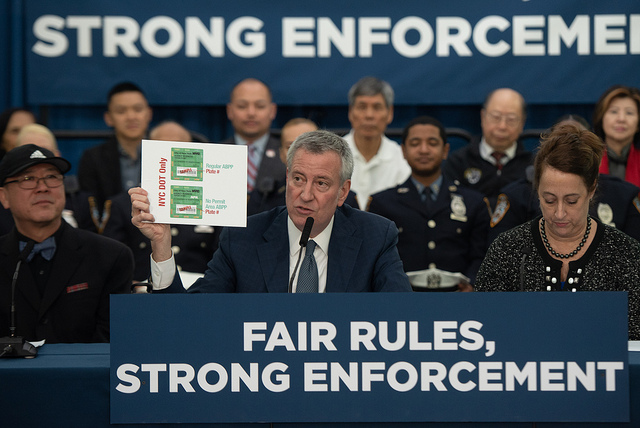De Blasio Cuts Two Placard Abuse Units That Did Nothing, Saying, ‘But Wait ’til Next Year!’

When it comes to fighting placard abuse, it seems the only thing Mayor de Blasio knows how to do is announce the latest crackdown, and then eliminate it before it even has a chance to start — the latest examples were just in the last few months, when the mayor axed two dedicated units that were supposed to help put an end to the low-level corruption.
Hizzoner axed the $5.4-million NYPD unit dedicated to stopping placard abuse, as part of small budget cuts to his police department that advocates say didn’t go far enough — eliminating all 116 officers and employees responsible for cracking down on public officials, especially cops, parking in front of fire hydrants, in crosswalks, in bike lanes and in bus lanes, and even on sidewalks.
The cut for the NYPD placard enforcement team, first reported by the Post, came after another $1.2 million was cut from the Department of Transportation for its own dedicated Placard Abuse Enforcement Team, which was announced with much fanfare more than a year ago, but was never actually created.
This is not only the latest example of the city giving up when it comes to fighting placard abuse, but it’s also yet another instance of the city turning a blind eye to police corruption, said Council Member Brad Lander.
“At a time when New Yorkers are demanding more accountability from the NYPD, not less, not only did we fail to make the significant cuts needed to begin transforming our public safety infrastructure, but it turns out that one small way that officers are held accountable for abusing their power was cut from the budget,” said Lander, whose cherished Dangerous Vehicle Abatement Program, which requires repeat speeding and red light offenders to take a driver-training course or have their wheels seized by the sheriff, was also cut.
Advocates who have been trying to put an end to placard abuse for years say that ending the four-year-old dedicated placard abuse team within the NYPD was the right thing to do — since it did nothing to stop the low-level corruption anyway at a cost of tens of millions of dollars.
“Since they were not actually performing the work, it was purely wasted money,” said one of the people behind the Twitter account Placard Abuse. “Paying additional employees to do the work the existing employees refuse to do was a costly cover up that tried to disguise itself as reform. It appears they did virtually no work at all while charging taxpayers tens of millions of dollars. The prior ‘reform’ became an opportunity for the NYPD to pad their budget.”
Please find out what "Issuer Command" code the placard enforcement unit used on the summonses it issued, @jfermino, and get back to us.
We would like to analyze the NYC OpenData.
Thanks!https://t.co/Q0WJr1HZhR @ndhapple @StreetsPAC
— placard corruption (@placardabuse) July 5, 2020
The cuts come after years and years of false starts on reining in placard abusers.
In November 2019, the City Council passed a nine-bill package that Speaker Corey Johnson said at the time would finally put an end to placard abuse. Among the bills was a requirement for the NYPD unit to conduct at least 50 “targeted enforcement sweeps” per week, monitored by the Department of Investigations and based on 311 complaints. Johnson said the new DOI oversight would finally give the crackdown the teeth it needs to succeed since cops often don’t like to ticket other cops, despite the fact that the DOI has also been caught abusing placards.
“They’re afraid of policing police — that is why we put in Department of Investigation as a check, an independent overseer,” Johnson said last year.
Before that, in February 2019, de Blasio announced a $52-million program to end placard abuse by eliminating the current system of laminated cards, and replacing it with a fully digitized system in 2021, called Pay-by-Plate. That program has not launched yet — more than 18 months later.
It’s unclear what any of these new programs or units created over the last three years ever actually did to crack down on placard abuse, which remains rampant all over town, including on streets targeted by alleged crackdowns, such as on Schermerhorn Street near the Transit Bureau 30 substation, and along Jay Street between Willoughby and Tillary streets.
A spokeswoman for the DOI said the weekly sweeps stopped once the pandemic struck, and couldn’t say when they would return. The NYPD did not respond to a request for comment about the outcome of the sweeps before they stopped, when they did, or if they even ever happened.
But a spokeswoman for City Hall says the new automated Pay by Plate system will make up for the now-cut NYPD and DOT units. The system will allow traffic enforcement agents to quickly scan a plate with a hand-held device that will automatically determine if it’s the placard is valid for the parking spot — and that’s why the city felt it no longer needed a dedicated placard abuse team in the NYPD budget.
“A dedicated unit is no longer needed because we are enhancing enforcement coverage by introducing new technology and other advancements that allow any TEA to do this work more seamlessly,” said mayoral spokeswoman Laura Feyer, who added that Pay-by-Plate is still fully funded and is slated to roll out after June, 2021.
That’s a long time to wait to stop placard abuse, which Johnson called the low-hanging fruit of street safety.
“We can’t send the message that placard abuse will be tolerated. A concerted effort directed at stopping this behavior must continue. We have more traffic enforcement agents focused on writing tickets now and we expect them to continue this work, particularly with the most egregious abuses like those who park in bike and bus lanes, and sidewalks,” said Council spokeswoman Jennifer Fermino.





